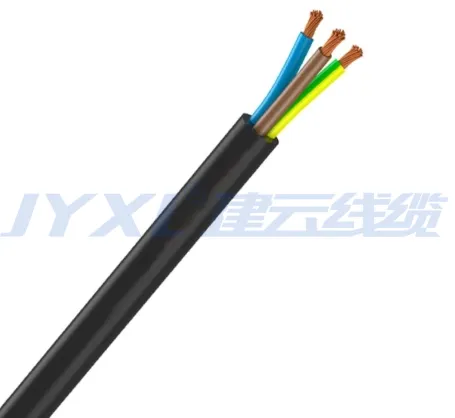Three-Core Cables: Applications and Functionality
Time: 2025-05-21 15:37:40
Source: Henan Province Jianyun Cable Co., Ltd.
Introduction to Three-Core Cables
A three-core cable is a type of multiconductor cable that contains three individually insulated conductors within a single outer sheath. These cables are designed to transmit electrical power or signals in systems requiring multiple phases or circuits. Widely used in various industries, three-core cables are essential for applications where reliable and efficient power or signal distribution is needed, particularly in three-phase electrical systems.

Design and Construction
Three-core cables are engineered to meet specific electrical and environmental requirements. Their key components include:
-
Conductors: Typically made of copper or aluminum for high conductivity, the three conductors are used to carry separate phases or signals.
-
Insulation: Each conductor is insulated with materials such as polyvinyl chloride (PVC), cross-linked polyethylene (XLPE), or ethylene propylene rubber (EPR) to prevent electrical interference and ensure safety.
-
Outer Sheath: A protective jacket, often made of PVC, polyurethane, or low-smoke zero-halogen (LSZH) materials, shields the cable from moisture, chemicals, and mechanical damage.
-
Armor (Optional): In applications requiring additional protection, such as underground or industrial installations, a metallic armor layer may be included.
-
Filler or Bedding: Non-conductive materials are used to fill spaces between conductors, maintaining cable structure and stability.
Primary Applications of Three-Core Cables
Three-core cables are primarily used in systems requiring three-phase power or specific control and signal configurations. Their main applications include:
-
Three-Phase Power Distribution: Three-core cables are widely used in three-phase electrical systems to transmit power in industrial, commercial, and residential settings. Each conductor carries one phase of the alternating current (AC), enabling efficient power delivery to motors, transformers, and heavy machinery.
-
Industrial Applications: In manufacturing plants and industrial facilities, three-core cables power equipment such as pumps, compressors, and conveyor systems, where three-phase power ensures smooth and efficient operation.
-
Utility Networks: Electric utilities employ three-core cables in medium- and low-voltage distribution networks, often in underground or aerial installations, to deliver power to substations or end-users.
-
Control and Instrumentation Systems: In some cases, three-core cables are used to transmit control signals or instrumentation data, such as in automation systems or monitoring equipment, where three conductors support multiple signal channels.
-
Renewable Energy Systems: Three-core cables are used in wind turbines and solar power plants to connect inverters and other equipment to the grid, supporting three-phase power transmission.
-
Marine and Offshore Applications: In ships and offshore platforms, three-core cables provide power to critical systems, with robust designs to withstand harsh marine environments.
Advantages of Three-Core Cables
Three-core cables offer several benefits that make them suitable for their applications:
-
Efficiency in Three-Phase Systems: They enable balanced power distribution in three-phase systems, reducing energy losses and improving system efficiency.
-
Compact Design: Combining three conductors in a single cable reduces installation space and simplifies cable management compared to using separate single-core cables.
-
Durability: Robust insulation and sheathing ensure reliability in harsh environments, such as industrial or outdoor settings.
-
Versatility: Available in various voltage ratings and configurations, three-core cables can be tailored to specific power or signal requirements.
Challenges and Considerations
While three-core cables are highly effective, certain challenges must be addressed:
-
Installation Requirements: Proper installation is critical to avoid issues like phase imbalance or mechanical stress, particularly in aerial or underground setups.
-
Environmental Factors: Exposure to moisture, extreme temperatures, or chemicals can degrade cables, necessitating appropriate sheathing or armor.
-
Electromagnetic Interference (EMI): In control or signal applications, shielding may be required to prevent EMI from affecting signal integrity.
To mitigate these challenges, three-core cables are designed to comply with industry standards, such as those set by organizations like the Association of Edison Illuminating Companies (AEIC), ensuring performance, safety, and compatibility with utility systems.
Installation and Maintenance
Effective installation and maintenance are essential for the performance of three-core cables:
-
Installation: Cables must be installed with proper tension and support, especially in aerial applications, to prevent sagging or damage. Underground installations require protection against soil movement and moisture.
-
Termination and Jointing: Accurate termination to equipment or junction boxes ensures reliable power or signal transmission.
-
Maintenance: Regular inspections for insulation wear, corrosion, or physical damage help prevent failures. Testing for phase balance and insulation resistance can identify potential issues early.
Future Trends
As electrical systems evolve, three-core cables are adapting to new demands:
-
Smart Grid Integration: Enhanced three-core cables are being developed to support smart grid technologies, enabling real-time monitoring and control.
-
Sustainable Materials: Eco-friendly insulation and sheathing materials are being adopted to reduce environmental impact.
-
Higher Voltage Ratings: Advances in insulation technology are enabling three-core cables to handle higher voltages for renewable energy and long-distance transmission.
-
Automation and IoT: In control applications, three-core cables are being optimized for compatibility with Internet of Things (IoT) devices and automated systems.
Conclusion
Three-core cables are critical components in three-phase power distribution, control, and instrumentation systems, offering efficient and reliable performance across diverse applications. Their compact design, durability, and versatility make them indispensable in industrial, utility, and renewable energy settings. As technology advances, three-core cables will continue to evolve, supporting the growing demands of modern electrical and communication networks with enhanced efficiency and sustainability.
